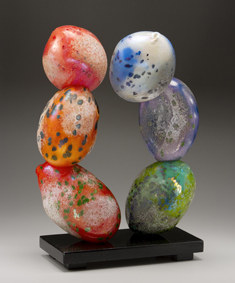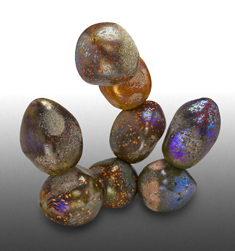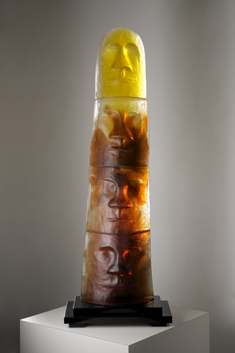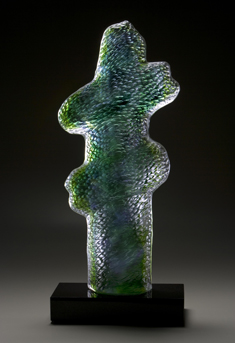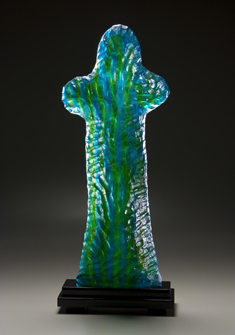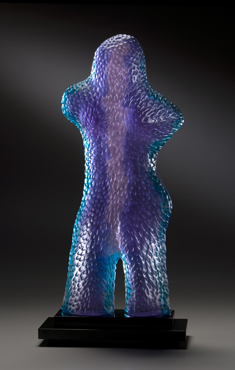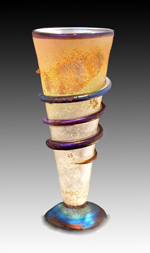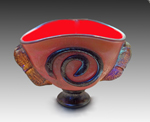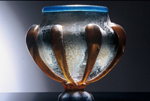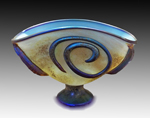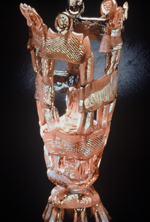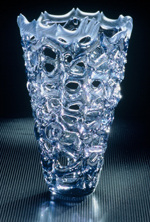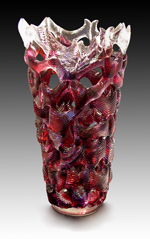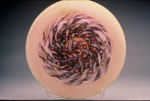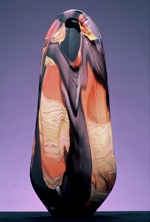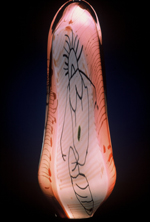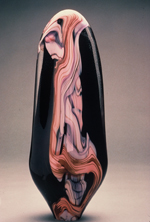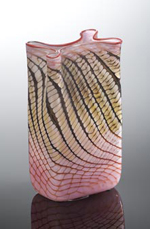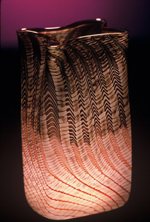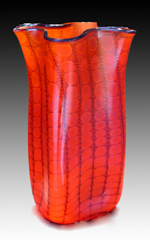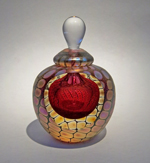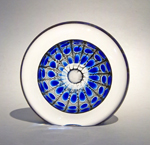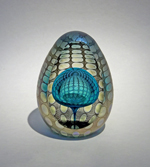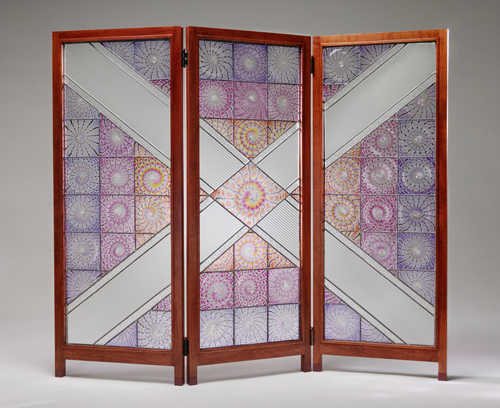This section describes the major series created throughout Philabaum’s career, beginning with the most current. The images shown are samples from each series. For available work go to “The Art” tab and scroll down to Philabaum.
Fused Glass Collage Paintings, November 2012 –
The Collage Paintings derive from a trip to Paris where Philabaum first saw exquisite glass paintings hanging in a sophisticated subway station. Fascinated, he returned home to tinker with ideas in his Tucson studio. That same summer, a rare glass gemmail painting by Picasso was discovered in storage in an Indiana museum. The discovery ignited a debate around the world on Picasso’s method that mirrored Philabaum’s investigations and questions. Ultimately, his methods were arrived at by his own experimentation. The glass collages include high-fired paint, silver and gold foil, and copper wire and screen.
 #44, 14″ x 14″, 2013 #44, 14″ x 14″, 2013 | |
 #35, 16.5″ x 12.5″, 2013 #35, 16.5″ x 12.5″, 2013 | |
Precarious Rock Series 2007 – 2018
The Rock Series came about by exploring shape-making techniques whose consequent was not a vessel. Through investigation into forms from nature, pollen grains, etc., he conceived of sculptures composed of many parts or fragments to create a whole. Some pieces have scavo surfaces, while others celebrate bright color combinations. The precarious notion comes from the fact that the “rocks” are faceted and laminated in seemingly gravity-defying positions.
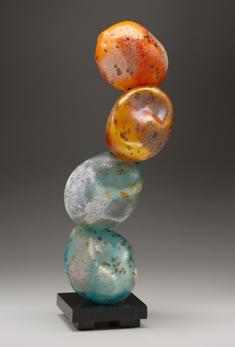 Ascending, 28″h, 2007 | |
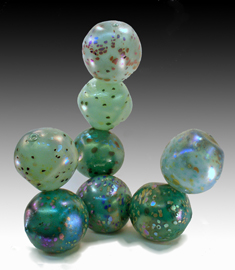 Serena, 20″h, 2009 | |
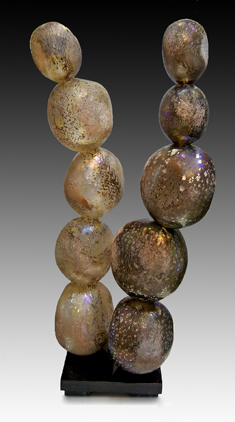 Two Points of View, 36″h, 2009 | 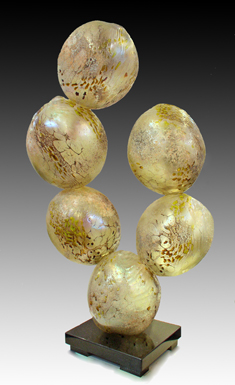 Fleur de Lis, 31″h, 2010 |
Kiln-Cast 2003
In 2003, Tom was one of 75 formerinstructors invited to Penland School of Crafts to participate in their 75th anniversary celebration, by working in any of the studios on campus that he wished. He chose to work in ceramics. It was there that he was inspired to make a large totemic piece in clay that would later be transposed into glass. Thus began the cast glass series, beginning with “Evo”.
Kiln-casting is the process of creating a mold (negative) from a positive in clay, wax, or wood. Once the mold is dried, fired, and cooled, it is filled with glass cullet (chunks), and fired in a kiln until the glass melts into the mold.
Scavo Series 1998 – 2018
Scavo is a form of surface decoration that creates a look of instant antiquity. Developed by the Italians (it means “unearthed”), scavo is a chemical attack on the surface of the glass. Once the piece is finished and still on the punty, the scavo mixture is lightly dusted onto the surface. A dangerous procedure due to the noxious fumes, scavo must be burned on or “set” by firing up to six times in the Glory Hole prior to annealing.
“Scavo is Italian, and we mix it like we make love…blindly.” Pinnochio
 Venerable Vessel,24″h x 10″w |  Scavo Zig Zag, 20″h, 1998 | |
Graal Series 1990’s
Tom’s painterly background in art led him to an interest in the Graal technique, where colored decorations are encased in clear crystal. For this work, a clear “blank” is blown, cooled, and hand painted with enamels. After drying, the piece is re-heated, picked up by a blowpipe, and encased in another layer of glass. With each new layer of glass, more painting is applied. The process continues through several layers, eventually resulting in a thick blown piece with an unusual three-dimensional illusion.
 |  The Skeptics, 14″h, 1994 |  Spacey Mesa, 18″h, 1994 |
 Waiters & Watchers, 18″h, 1994 |  Drinking with the Devil, 20″h, 1995 | 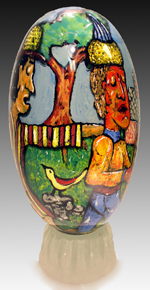 The Blind Leading the Blind, 18″h, 1996 |
Rhiza Series 1988-1990
The word Rhiza comes from the Greek word for “root”. This series of vessels had a graphic quality not seen in other Philabaum designs.
 |  |  |
Handbuilt Series 1987 – 2007
This series was born out of Tom’s long time interest in hand-building with clay. “I wanted to break from the traditional method of blowing molten glass.” The result was “hand-building” large vessel forms with hot glass slabs and later, with hot coils. The construction of one of the sculptures consisted of a sweaty drama involving Philabaum, thirty pounds of molten glass, and six assistants. The difficulty of maintaining consistent heat throughout the piece as it grew larger was one of the major challenges.
The Temple Series and later the Canasta (Sp. for “basket”) Series are all derivatives of the Handbuilt Series.
 Handbuilt Slab, 16″x11″, 1988 |  Temple w/ Oil Paint, 12″h |  Serpentine Canasta, 15″, 1990 |
Perseid Series 1985
This series was developed by the partnership of Philabaum and Bob Carlson. It was inspired by the Perseid Meteor Showers that occur in northern August skies. It featured great swaths of star-like studded colors.
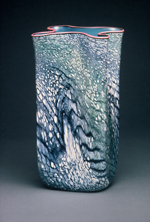 | 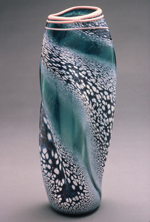 | 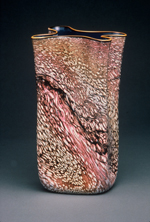 |
Medulla Oblongata 1984 – 1985
This series was also developed under the partnership of Philabaum and Carlson. It is loosely derivative of the spinal cord connection, and the vortex that is created by this technique. The three forms on the 2nd row are Transformational Histoliths, the closed top sculptural finale of the Series.
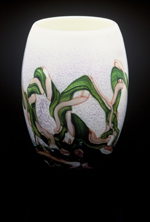 | 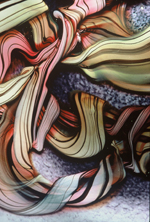 | |
Reptilian Series Late 1970’s – 2018
The Reptilian pattern, both a process and an outcome, has been the most enduring design element at Philabaum Studios. Though not intended to look like anything in particular, the finished pattern has been said to resemble a backbone, fish scales, snakeskin, and even teeth. Despite that range of descriptions, the reptilian name is the one that stuck early on. Above all, the pattern is always striking, and has become the most long-standing signature look for the designs of Tom Philabaum, used on a wide variety of products. Below are examples of work with the reptilian pattern, including a one-of-kind room screen, called “The Equis”.
Bag Series 1980’s and still going….
The Bag Series developed in the early 80’s, beginning with a “grocery bag” shaped vase, seen in its early configuration in the Histology Series below. As the bag developed, other shapes, like the V-Bag and the Hexa- Bag also emerged. These bags featured the Reptilian, Perseid, and Rhiza design motifs, as seen on this page.
Histology Series 1978 – 1983
Tom was always interested in the visuals from the microscopic cell and tissue study of plants and animals. From this fascination came his early histology pieces, with cell-like motifs and microscopic images. You can also see examples of the very early “bags” in the images below.
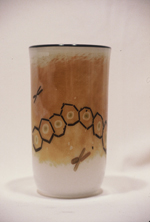 | 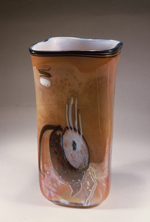 | 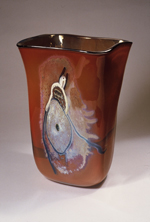 |



